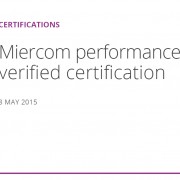5 reasons to upgrade your SBC
The Session Border Controller (SBC) market is being disrupted by the need for greater quality of service and experience in IP networks. For too long, traditional SBCs have relied on reviewing call data records after sessions have taken place to estimate session quality and network performance.
When you are evaluating your options when upgrading your SBC, keep these things in mind and look for a solution that is ready to enable the next generation of high performance applications and communications services.
Here are five reasons to upgrade your SBC:
- The Need for New Visibility
The migration from TDM to IP is driving the need for deeper visibility into the network. TDM networks have been reliable, predictable and providing the best QoS/QoE in contrast with the IP networks. Migration from TDM to IP will be accelerated if the all IP infrastructure can provide the reliability, predictability and the service level QoS/QoE over the IP networks. The traditional SBC approach of highlighting the QoS by generating a call record after the call has taken place and estimating what happened during the session is no longer sufficient. Ensuring that service level quality of service on IP matches or surpasses TDM requires proactive and real time monitoring of performance as calls and sessions take place.If you are migrating to IP, you need an SBC that can deliver real time QoS on IP with session quality monitored during, not after a call is made. - New Efficiency in Multiservice Infrastructure
The service environment for most network operators is becoming more diverse and dynamic. This requires an infrastructure that is prepared to address the different IP based service/database infrastructures in the service provider’s network and manages different services, ideally, with the same infrastructure. With the traditional systems, creation of new services means that they need to develop software on an individual service basis. It is inefficient and lacks the agility to rapidly roll-out new services.When choosing an SBC look for a highly customisable Service Management Framework. A Service Management Framework eliminates the need for individual software development cycle on a service-to-service basis and one that is forward looking that enables the rapid deployment of new services like WebRTC etc. - Session Quality = Enhanced User Experience
To enable true Quality of Experience (QoE) for end users, SBCs must offer deeper analysis of session quality. Basic session analytics are not good enough anymore. Just looking at packet statistics, jitter, packet loss then estimating QoE does not guarantee the end user is receiving a satisfactory service.New SBCs must look into packets for deeper voice quality analysis and offer a scoring system for average quality. Only then will you be able to estimate the QoE. - Real-Time SLA Monitoring
SLA monitoring and routing to maintain SLAs is a real pain point for operators. Static routing lists and manually updating routing makes it difficult and resource intensive to deliver on SLAs. This, in turn, makes it difficult to charge for higher levels of service.An SBC that enables dynamic QoS-based routing can automate the process to simplify SLA management for the operator. Also, SLAs can be programmed into the SBC for monitoring and alerting via a graphic user interface. The real time QoS based analytics collected is fed back into this dynamic routing analysis to ensure that the SLAs are maintained at the required level. This simplifies SLA management process for the operator and turns a pain point into an advantage. - Solving Signalling Issues
Growth in LTE deployments and the growing complexity of signalling means that inefficiency in the network is growing. Currently voice over LTE is often handed to legacy Circuit Switch Fall Back for delivery; the de facto standard to do native VoLTE is via IMS. With the deployment of VoLTE over IMS, there has been an emergence of IP islands where LTE-to-LTE calling is easy but presents challenges when terminating off-net to a non VoLTE/non-IMS NGN SIP network.A built-in Signalling Procedure Adaptation Framework in the SBC can remove this complexity and allow for the conversion of traffic across disparate network and service types. Networks don’t need to be operated in parallel (as in the case of CS fall back) as operators can migrate to homogeneous IP based infrastructures.
These five things are emerging as key features for the future of IP networks. Some people ask if we have so far advanced beyond what SBCs are offering today, are we really talking about an SBC anymore? If you’d like to discuss this and the future of intelligent networks, please get in touch.













